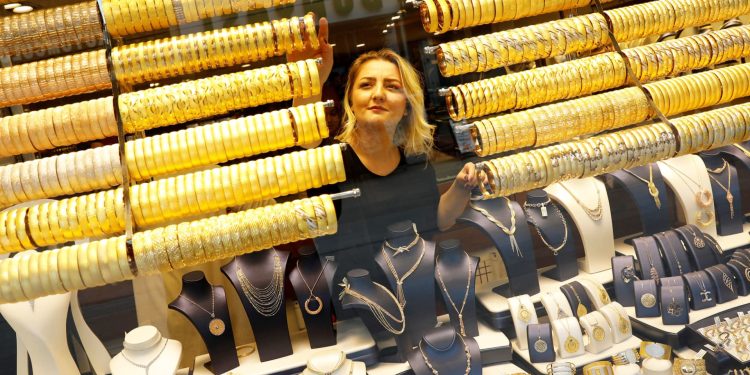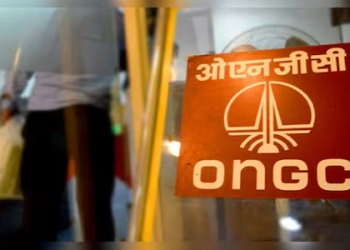Gold prices held steady on Thursday, hovering near the previous day’s record high, helped by expectations of U.S. tariff cuts and political uncertainty.
David Gray | AFP | Getty Images
Amid global economic turmoil, prices of precious metals have been climbing higher and higher.
The price of gold In particular, has skyrocketed over the past year, increasing by over 50%. For mid-sized jewelry companies aiming to offer fine gold necklaces, earrings and more At prices lower than legacy luxury jewelry brands, gold futures could be spelling problems.
Although gold is often subject to market fluctuations, investors have increased their holdings over the past year amid recession fears and market uncertainty, according to Goldman Sachs. Gold is on pace for its third straight year of double-digit gains, with record highs this week during the government shutdown.
On Tuesday, gold prices hit $4,000 an ounce for the first time in history – and they show no signs of slowing down.
UBS analysts wrote last week that falling interest rates, a weak dollar and political uncertainty will only increase the price of gold.
“We now expect inflows for this year to be 830 metric tonnes, which is almost double our initial forecast of 450 metric tonnes at the start of the year,” UBS analysts wrote in a note. “Gold’s key risk is better U.S. growth and whether the Fed is forced to raise rates due to inflation-related upside surprises.”
A Goldman Sachs report from late this month predicted the rise, projecting that the price of gold will rise 6% through the middle of 2026 to $4,000 per Troy ounce, a unit of measurement used for precious metals. The report categorized gold buyers into two groups: conviction buyers, who buy the metal consistently, and opportunistic buyers, who jump in “when they believe the price is right.”
Analysts said they expect central banks to continue buying gold for three more years.
“Our rationale is that emerging market central banks remain significantly underweighted relative to their developed market counterparts and are gradually increasing allocations as part of a broader diversification strategy,” wrote analyst Lina Thomas.
And according to July survey data from the World Gold Council, about 95% of central banks expect Global Gold Holdings to rise next year.

Golden future
This uncertainty comes from an already turbulent global economy reeling from President Donald Trump’s tariff policies. Although he made it clear in August that gold will not be tariff-free and Swiss bars will not be subject to the country’s 39% tariff, Trump’s heavy-handed tariffs on other countries have disrupted the global supply chain.
For jewelers, the rising price of the precious metal can be a source of concern. Major retailers like Pandora and Seal have signaled they are exploring price hikes or alternative manufacturing methods to counter the hit they are taking from gold.
And some jewelry companies that aim to offer gold products at lower prices, like Mejuri, are also feeling the pressure.
Mejuri, which aims to sell Gold and luxury jewelry at more affordable levels than its competitors, announced last month that the company was forced to increase its prices due to the rising cost of gold, silver and tariffs.
“While we have done everything possible to absorb the impact and preserve the quality and craftsmanship you have come to expect from us, you will see updated pricing on Monday, September 29,” Mejuri wrote in an email to customers. “We are tackling these changes head on: streamlining our supply chain, strengthening sourcing, and designing with price in mind.”
The company said it is also innovating new products like 10 Karat Solid Gold to continue offering quality jewelry at affordable prices. Mejuri declined to comment.
‘A fear indicator’
With the price of gold rising and showing no signs of stopping, some jewelry companies are forced to be innovative with their pricing and products.
In its second-quarter earnings report in August, Pandora said it faced an 80-base point from rising gold and silver prices and had planned price adjustments to offset those headwinds. And during Signet’s most recent earnings call in early September, the company said it had experienced a more than 30% increase in the cost of gold.
Baublebar, which specializes in fine jewelry, offers a large selection of “Demi-Fine” gold pieces, which co-founder Daniella Yacobovsky says has allowed the company to somewhat avoid the crude of gold price pressure.
The company’s demi-fine jewelry features thick, 18k high-quality gold plating over a sterling silver base, allowing Baublebar to avoid the costs associated with solid gold jewelry. The brand’s demi-thin earrings range from $50 to $150.
“We’ve actually seen a really huge increase in interest in Demi-Fine,” Yacobovsky told CNBC. “I think it gives people a really fantastic alternative to solid gold. … You’re going to get really fantastic quality similar to that for a lower price.”
Still, Yacobovsky said it’s concerning that significant events affecting the global economy are occurring at higher rates than five years ago. She said she hasn’t seen anything as volatile as the skyrocketing price of gold in the industry “in a long time.”
The key, she said, will be for businesses to capitalize on their ability to make smart choices.
For Alexis Bittar, CEO of her eponymous jewelry company, The Smart Choice meant leaning into gold-plated pieces, which allows the company to save costs on solid gold and raise prices slightly to match the products that are arriving.
But the company isn’t repainting any of its existing products, Bittar said.
“You’re constantly juggling the tariff and accelerating gold prices, so you’re staying in a price that you’re known for,” Bittar said. “On the consumer side, they don’t really care. They know vaguely that gold prices are going up…but mentally they have an unconscious price that they’re looking to spend, and when you start to go beyond that, you’re pricing people out.”
Bittar said his company sees a “cautious” consumer, but that any decline in spending is likely more related to solid gold than clad gold, and that the wealthy consumer base is more willing to pay higher prices than lower- or middle-income buyers.
Even for ear piercing company Rowan, which also offers gold jewelry, the fast-paced industry can cause spelling problems. CEO Louisa Schneider told CNBC it was hard to imagine any other industry whose raw material costs had risen as dramatically as gold.
Rowan Piercing Studio’s suburban location in Ardmore, PA.
Courtesy: Rowan
Since ear piercing requires a certain level of surgical steel or titanium for ideal healing, Rowan often uses 14-karat gold to coat these materials, leaving the company “somewhat insulated” from the rising price of gold because it is necessary to maintain certain health and safety standards.
Still, Schneider said Rowan had to raise prices on some of its gold coins early in the third quarter, which he said customers were willing to pay because the company specializes in employing trained nurses for piercings.
“It’s a fear indicator. So, from my perspective, is quite concerning,” Schneider said. “Our expectation is that we don’t see a significant reduction in current prices – if anything, we expect gold to continue to be quite expensive. So we will continue to hedge and work very closely with our suppliers.”
Schneider said she sees an “inflection point” in the price of gold and that it’s a cause for concern for all jewelry companies, but especially those who are unable to raise their prices to counter costs as they sell to non-luxury consumers who are less flexible with price changes.
Ultimately, she said this serves as a warning sign for the broader economy, even if it didn’t hit Rowan too hard.
“The demand is not coming from consumers who want to wear gold or from industries that require gold as a component in manufacturing,” Schneider said. “This comes from a hoarding of gold given uncertainty around the U.S. dollar, and it’s unlike anything we’ve seen.”
Correction: A previous version of this story incorrectly expanded Signet sales.









